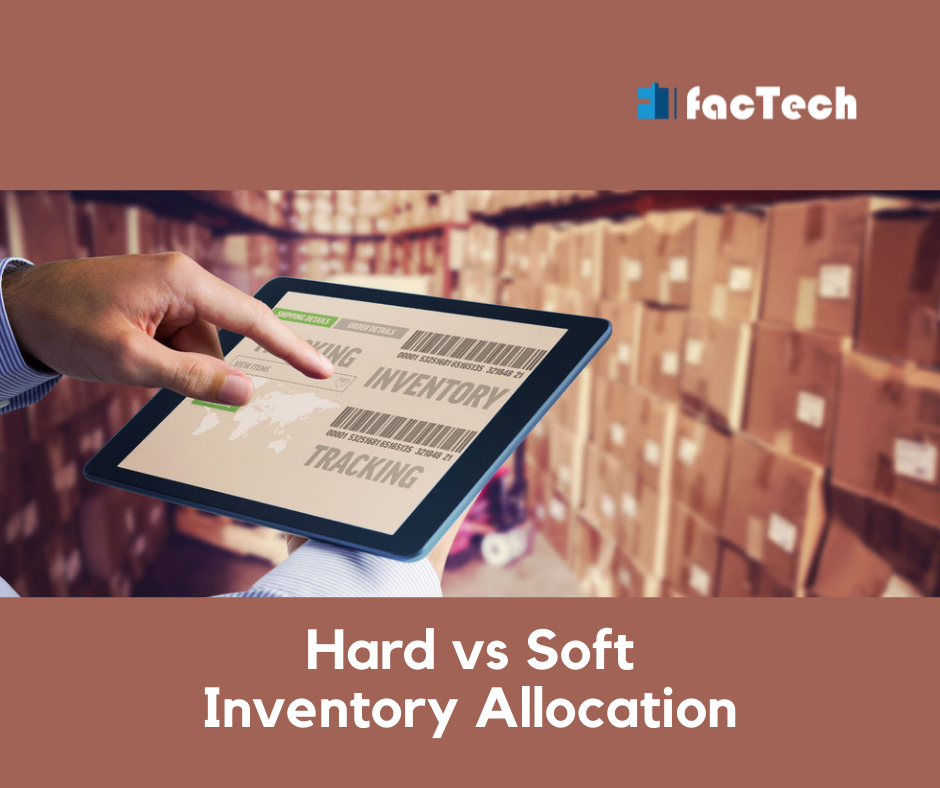Hard vs Soft Inventory Allocation
Hard vs Soft Inventory Allocation
Gaining control over your company’s inventory allows you to meet customer demand and minimize supply chain challenges. The key to inventory control is inventory allocation, which is the process of tracking inventory across your network. Your network might include warehouses, distribution centers and brick-and-mortar stores. With the correct allocation of stock, you can avoid stockouts and keep products from languishing on shelves.
Inventory allocation falls into two broad categories: soft and hard. Learn more about the difference between soft and hard allocation and when each might be appropriate.

Hard Inventory Allocation
Hard inventory allocation is more rigid than soft allocation and has much less, if any, wiggle room.
In the clothing example, as the spring season gets closer, you’ll need to firm up your order numbers. Pre-orders might have started to come in from customers, and maybe the demand for plaid shirts is way less than you anticipated.
You now know exactly how many shirts to order. There’s no flexibility in your inventory at this stage. If you order too many shirts, you may not be able to sell them all. If you don’t purchase enough, you can’t fulfill customer orders.
Soft Inventory Allocation
Usually, soft inventory allocation occurs early on in the ordering or manufacturing process. It provides you with the flexibility you need to make changes as required.
For example, if you own a clothing company, you might start planning the spring season during the previous summer.
Early in the planning stages, you have a general idea of what will be trendy in the spring. Plaid shirts and mini skirts might be predicted to be the big sellers next spring, so you start placing orders for both those items with that in mind.
You’re not sure what colors will be trendy or how the clothing will sell, so you make a guestimate. Since it’s early in the process, you have the option of adjusting your order up or down as needed.
Hard Inventory Allocation
Hard inventory allocation is more rigid than soft allocation and has much less, if any, wiggle room.
In the clothing example, as the spring season gets closer, you’ll need to firm up your order numbers. Pre-orders might have started to come in from customers, and maybe the demand for plaid shirts is way less than you anticipated.
You now know exactly how many shirts to order. There’s no flexibility in your inventory at this stage. If you order too many shirts, you may not be able to sell them all. If you don’t purchase enough, you can’t fulfill customer orders.
Critical Differences Between Soft and Hard Inventory Allocation
Soft and hard allocations are more than just opposites of each other. Depending on your company’s goals, they can be partners. You might need soft allocation for one area of your supply chain and hard allocation for another. In some cases, soft allocation can become hard as the due date or delivery date approaches.
Here are some key differences between the two:
- Timing: Generally speaking, soft allocation is necessary early in the process, while hard allocation comes later. You’re likely to soft allocate products when you’re still planning a season or product line. Soft allocation can help you create a budget for the year, too, since you can change order amounts and even products themselves. Hard allocation comes into the picture much later, when things are ordered and on their way to the store or the customer.
- Flexibility: Soft allocation is the more flexible of the two. If you need to cancel an order, you can. With hard allocation, you might still be able to adjust or cancel orders, but there are likely to be more consequences, such as stockouts or extra fees.
- Goals: Soft allocation focuses on planning. You use it when you’re coming up with ideas for your business’s future, based on trends and forecasts. The goal of hard allocation is usually execution. You use it when it’s time to start sending out products, whether to your distribution centers for shipping or directly to your customers.
Managing the Supply Chain
Developing an allocation strategy that includes hard and soft allocation allows you to manage your company’s supply chain better — and an inventory management system can help. You can use an inventory management system for auditing your stock and evaluating inventory levels and turnover at multiple locations. With that information, you can decide how much stock to order for each location.
Early in the season or planning process, soft allocation can be the superstar of supply chain management. You can use sales forecasting to estimate how much stock to order and to predict future demand. But at this stage, you don’t want to set anything in stone. Reserving the option to cancel orders or increase order size is the way to go at this point.
Later, when the season has arrived, your focus should shift to hard allocation. At this stage, you have a firmer idea of the demand for products based on orders and your existing inventory.
When it’s time to switch to hard allocation, you need to also think about fulfillment. You might need to combine orders or increase order size to meet shipment requirements. You want to have the most inventory shipped to your warehouses for the lowest cost.
Planning Process Challenges
When it comes to allocation, you want to find the right combination of soft and hard allocations.
However, some challenges can come up that make it difficult to strike the right balance. For example, your initial forecast could end up being way off. Perhaps you listened to a trend forecaster who missed the mark, or the public went in a direction no one expected. You might find yourself with thousands of plaid shirts that no one wants to buy.
One way to overcome that sort of challenge is to wait to switch to hard allocation until you’ve gotten some orders in. Then, you have some solid numbers to use to estimate future demand for the product. For example, let’s say you soft allocated an order for 1,000 plaid shirts but waited to make the final purchase until you got some orders.
Once pre-orders opened, demand was impressive. You received 500 pre-orders in less than an hour. You can feel confident finalizing the purchase of those shirts based on early, concrete demand.
Now, let’s say that you finalized the shirt sale before you got a concrete idea of demand. You launch pre-orders, and only a few trickle in. Since you switched to hard allocation too early, you might be stuck with shirts no one wants.
Patience is key when it comes to inventory allocation. Wait until you have a firmer idea of how much your company will need before committing to any orders.
To learn more about how it works, contact us today to schedule a demo.











Leave a Comment